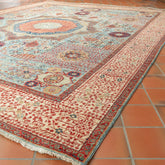PREVENTING MOTH DAMAGE IN YOUR HOME
HOW TO PREVENT MOTH DAMAGE
The 'M' Word
Dare we mention the dreaded ‘M’ word. It is often not discussed and yet remains a constant destructive force in many homes - moth!
However, there are only a couple that cause problems for us, the rest are fabulous and should be admired, not demonized.
The moth we are interested in is Tineola bisselliella, a small moth at 5’8mm long, and Monopis crocapitella which is larger and is distinctive with its brown colour and pale back.

Sadly, these moths can become major problems, eating their way as tiny larvae through cloths, curtains and carpets…and our prized handmade rugs.
In most cases, these will be unseen and difficult to spot. Usually, the early warning signs are flying adult moths which flit around in an almost awkward flight. They hate the light and usually prefer to be low down out of sight.
Spot one and you already have a problem - I have seen infestations in homes which would horrify many!
The Life Cycle of a Moth
To wage war on this invasive insect, we must first understand its life cycle.
Adult male moths can detect female moths at some distance due to the pheromone excreted by the female moth to ensure successful mating. After which the female deposits 50 or so eggs into the piece, over a relatively long period of up to 3 weeks.
The larvae that hatch is the real problem. They are voracious feeders and tend to stick out of sight in undisturbed places such as; wardrobes, under cupboards, beneath beds and in the base of pile carpets and rugs, particularly those that are not walked on regularly.
Here, they will feed for a couple of months in most conditions - temperature has a bearing on this so it can be longer (which means more time for them to snack on your treasured item!)
Having had a good feed, they pupate wrapping themselves in a cocoon of silk and excrement. They will look like grains of rice as they continue to gorge themselves until finally, they are ready to emerge as an adult breeding moth then the cycle will all start again.
What is difficult to understand, is why they find fabric so delicious? It is a simple answer - Keratin! Which is particularly available in wool.
The challenge is to break the cycle and get rid of the adult moths, particularly the males.

How to rid your home of moths
We have several ways how this can be done. Firstly, if you have an infested rug, don’t bring it to us! The best solution is to place it in a large freezer and keep it there for a couple of weeks. It’s the best ‘sure’ remedy for dealing with them as it destroys eggs larvae, and pupae. It’s also chemical free.
If a rug is badly infested and the rug is missing the pile it may not be cost-effective to repair so I’m afraid in some circumstances the item needs to be destroyed.
If you wish to take a proactive approach, our cleaning service now offers an additional treatment which can ensure eggs and any rogue larvae or pupa are killed. We do this by applying a synthetic chemical spray of Permethrin, which is a synthetic version of the oils extracted from the chrysanthemum flower.
We do, however, also have a natural chemical-free product from Total Wardrobe Care who specialise in supplying the home with products across the spectrum suitable for rooms, wardrobes, and drawers.
For our purposes, we have selected a couple of products made from Chrysanthemum extract which is sustainably sourced from independent farms in Kenya and mixed with essential oils. This contains natural active ingredient pyrethrum which is from the flower heads. It has an insecticidal effect and kills on contact. You can check out the Jennings range of products on our site now.
In addition to treating the room, rug or furnishings with an effective product, you should also consider adding Moth traps which will catch the male moths before they can mate. They will be attracted to the moth trap due to a synthetic moth pheromone (highly desirable to male moths) on the trap. These then have a sticky surface which traps the moths - Job Done!
We're currently stocking moth boxes, moth box refills and moth spray on our online store.
____
Illustrations provided by Holly Khraibani, a local artist, who documented her process in creating this beautiful illustration, especially for Jennings.











Leave a comment
Please note, comments need to be approved before they are published.